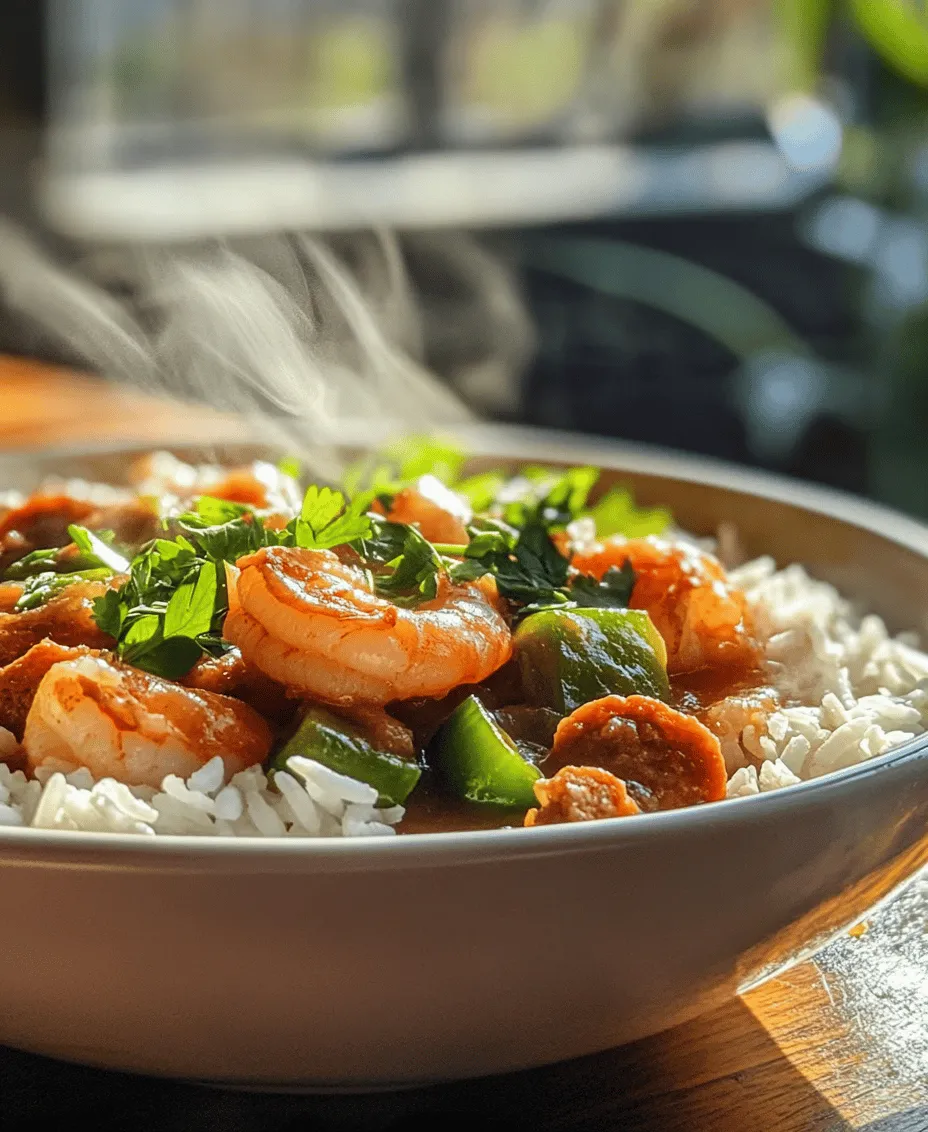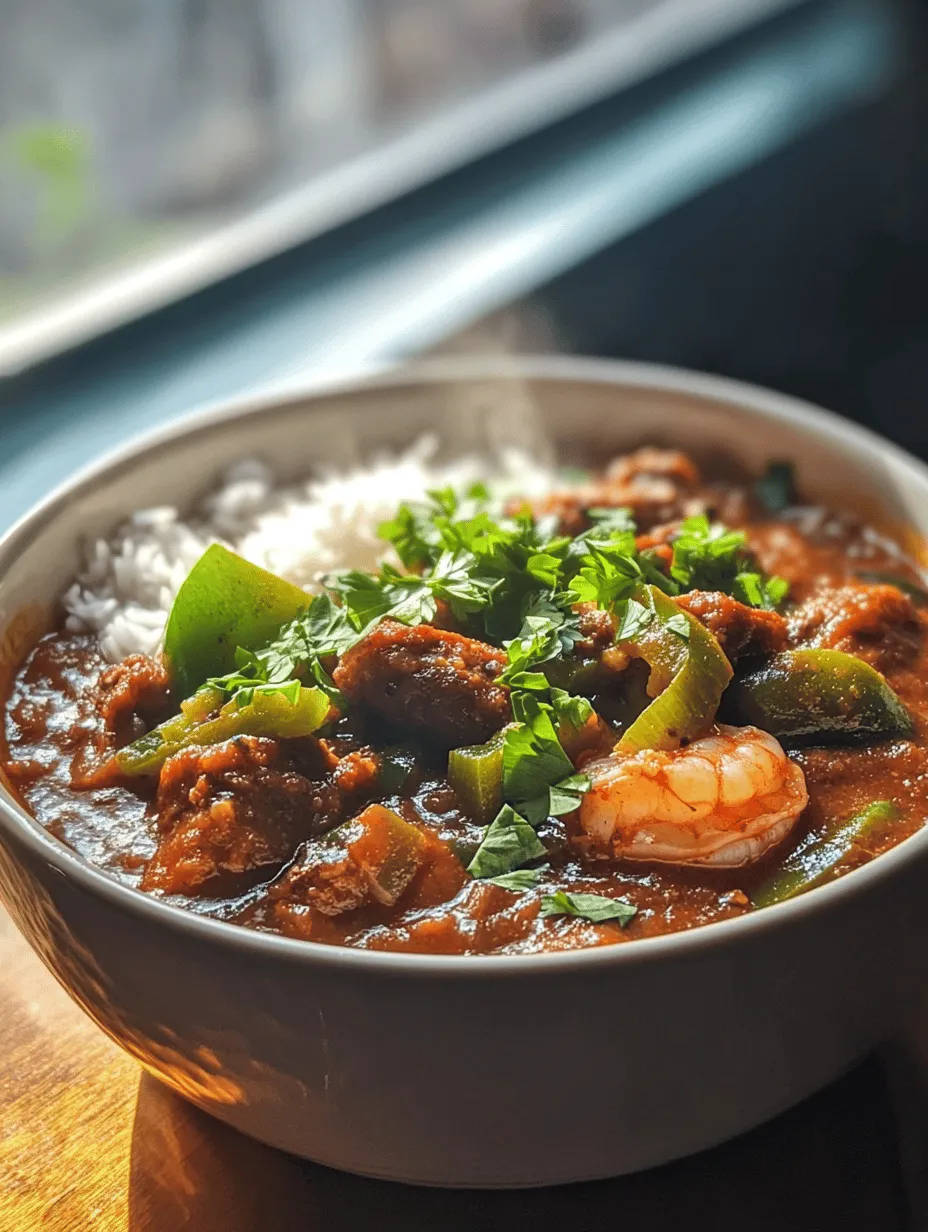Introduction
Delve into the heart of Southern cuisine with this Hearty Shrimp and Sausage Gumbo Delight. Known for its robust flavors and soulful warmth, gumbo is a cherished dish that brings together a variety of ingredients in a harmonious blend. This blog post will guide you through the origins, preparation, and enjoyment of this classic recipe, ensuring you can create a delicious pot of gumbo that your friends and family will love.
Gumbo is more than just a meal; it’s a celebration of cultures and a testament to the rich culinary traditions of the Gulf Coast. Originating from Louisiana, gumbo is a dish that reflects the melting pot of influences from African, French, Spanish, and Native American cuisines. Each region and household often adds its own twist, making gumbo a versatile and personalized dish. Whether served at family gatherings, Mardi Gras celebrations, or a simple weeknight dinner, gumbo embodies the spirit of comfort food, warming both the body and soul.
In this article, we’ll explore the fascinating history of gumbo, break down the essential components that make this dish special, and provide you with step-by-step instructions to create your own Hearty Shrimp and Sausage Gumbo Delight. Prepare to embark on a culinary journey that will introduce you to the flavors of the South while keeping your kitchen filled with delightful aromas.
Understanding Gumbo: A Culinary Tradition
Exploring the History of Gumbo
The origins of gumbo can be traced back to the early 18th century in Louisiana, where it emerged as a unique blend of culinary traditions brought by various settlers and indigenous peoples. The word “gumbo” itself is believed to derive from the West African term for okra, “gombo,” which is one of the key thickening agents used in traditional recipes. The dish reflects the diversity of its roots, borrowing techniques and ingredients from African, French, Spanish, and Native American cuisines.
In the early days, gumbo was a simple stew made with whatever ingredients were available, often incorporating game meats, seafood, and vegetables. As the dish evolved, so did its complexity; different regions began to develop their own versions, resulting in a variety of gumbos that use distinct proteins, spices, and thickeners. For example, Creole gumbo typically features tomatoes and seafood, while Cajun gumbo leans towards heartier meats like sausage and chicken. Each family often has their own cherished recipe passed down through generations, making gumbo a beloved comfort food that carries the stories and traditions of those who prepare it.
The Essential Components of Gumbo
At the heart of every delicious gumbo lies a few essential components that define its flavor and texture. Understanding these key elements will help you create a gumbo that honors tradition while allowing for your personal touch.
1. The Roux: The roux is the foundation of any great gumbo. Made by cooking equal parts flour and fat (traditionally oil or butter) together, the roux is essential for thickening the soup and imparting a rich, nutty flavor. The color of the roux can vary from light beige to deep brown, with darker roux providing a more intense flavor. Achieving the perfect roux requires patience and attention, as it can easily burn if not monitored closely.
2. The Holy Trinity: This term refers to the trio of vegetables that form the aromatic base of gumbo: onion, bell pepper, and celery. Often referred to as the “Cajun Trinity,” these vegetables work together to create a depth of flavor that is essential to the dish. The combination of sweet and savory notes from the onions and bell peppers, balanced with the freshness of celery, provides a solid foundation for the gumbo.
3. Proteins: Gumbo is famous for its variety of proteins, which can include shrimp, sausage, chicken, and even crab or fish. In this recipe, we focus on shrimp and andouille sausage. Andouille sausage, with its spicy and smoky flavor, adds richness and depth to the dish, while shrimp brings a delicate seafood essence that balances the heartiness of the sausage.
4. Seasonings: Seasoning is crucial in gumbo, as it enhances the flavors of the other ingredients. Cajun seasoning, a blend of spices that often includes paprika, cayenne, garlic powder, and thyme, is commonly used. Fresh herbs like parsley and bay leaves are also added for additional flavor. The right blend of spices will elevate your gumbo, giving it the signature kick that makes it so irresistible.
5. Broth vs. Stock: The choice between broth and stock can significantly impact the final flavor of your gumbo. Stock is made by simmering bones and vegetables, resulting in a rich and gelatinous base, while broth is made primarily from meat and vegetables, leading to a lighter flavor. For a hearty gumbo, using a good quality chicken or seafood stock will provide the best results, contributing to the overall depth of flavor.
Ingredient Breakdown: What You Need for Hearty Shrimp and Sausage Gumbo
Creating a Hearty Shrimp and Sausage Gumbo Delight requires fresh, high-quality ingredients. Let’s take a closer look at the key components that will come together to create this flavorful dish.
A Closer Look at Key Ingredients
– Andouille Sausage: This smoked sausage hails from France but has become a staple in Cajun and Creole cooking. Known for its spicy flavor profile and coarse texture, andouille sausage adds a hearty dimension to gumbo. When selecting andouille sausage for your gumbo, look for high-quality options that contain natural spices and no artificial additives. The flavor of the sausage will permeate the gumbo, enhancing its overall richness.
– Shrimp: The star protein of our gumbo, shrimp is not only delicious but also quick to cook, making it an ideal choice for this dish. When choosing shrimp, opt for large, fresh shrimp or frozen shrimp that have been properly thawed. Look for shrimp that are firm to the touch and have a mild, ocean-like aroma. If possible, buy shrimp with the shells on, as they can add additional flavor to the gumbo.
– Vegetables: The holy trinity of onion, bell pepper, and celery is essential for building the flavor base of the gumbo. Each vegetable contributes its unique taste, and together they create a wonderful aromatic foundation. Use yellow onions for sweetness, green bell peppers for their mild flavor, and celery for its refreshing crunch. Dicing these vegetables uniformly ensures even cooking and flavor distribution.
– Seasonings: The seasoning blend is critical for imparting the distinctive taste of gumbo. Cajun seasoning is typically a mix of paprika, cayenne pepper, garlic powder, and various herbs. You can either purchase a pre-made blend or create your own to suit your taste preferences. Fresh herbs like thyme, bay leaves, and parsley will also enhance the flavor profile and add brightness to the dish.
– Broth vs. Stock: As mentioned earlier, the choice between broth and stock can greatly impact the flavor of your gumbo. For a rich and savory gumbo, opt for a quality chicken stock that has been simmered with aromatic vegetables and herbs. Alternatively, seafood stock can be used for a more pronounced seafood flavor. If you have the time, consider making your own stock using shrimp shells and vegetable scraps for an extra depth of flavor.
Step-by-Step Instructions: Crafting Your Gumbo
Now that you have a clear understanding of the history and essential components of gumbo, it’s time to get into the nitty-gritty of crafting your Hearty Shrimp and Sausage Gumbo Delight. The preparation process may take some time, but the result will be well worth the effort.
Creating the Perfect Roux
The roux is the cornerstone of a flavorful gumbo, and making it correctly is vital. Here’s how to do it:
1. Gather Your Ingredients: You’ll need equal parts vegetable oil and all-purpose flour. For this recipe, start with about 1/2 cup of each.
2. Heat the Oil: In a large, heavy-bottomed pot or Dutch oven, heat the vegetable oil over medium heat. Be patient and allow the oil to warm up, but do not let it smoke.
3. Add the Flour: Gradually whisk in the flour, stirring continuously to create a smooth mixture. It’s essential to keep stirring to prevent the roux from burning.
4. Cook the Roux: Continue to cook the roux, stirring constantly, for about 15-20 minutes. The goal is to achieve a deep brown color—similar to that of chocolate—while maintaining a smooth consistency. This process develops the nutty flavor of the roux that will enrich your gumbo.
5. Watch for Color Changes: As the roux cooks, it will go through various shades, from light blonde to caramel to dark brown. Pay close attention, as it can quickly go from perfect to burnt. If it begins to smell bitter, you may need to start over.
By mastering the roux, you’ll set the stage for a gumbo that boasts rich, complex flavors.
Building the Flavor Base
With your roux perfected, it’s time to build the flavor base for your gumbo.
1. Sauté the Holy Trinity: Once the roux reaches the desired color, add the diced onion, bell pepper, and celery (the holy trinity) to the pot. Stir the vegetables into the roux, allowing them to cook for about 5-7 minutes until they soften and the onions become translucent. This step is crucial as it allows the flavors to meld beautifully.
2. Add Garlic: After the holy trinity has softened, add minced garlic to the pot. Garlic enhances the flavor profile and adds a wonderful aroma. Sauté for an additional 1-2 minutes, taking care not to let it burn.
3. Incorporate Seasonings: Now it’s time to add your seasonings. Sprinkle in your Cajun seasoning, bay leaves, and any additional herbs you desire. Stir well to coat the vegetables in the spices, letting them toast slightly to release their essential oils.
4. Deglaze with Broth: Next, pour in your chicken or seafood stock, stirring constantly to combine. This will help lift any flavorful bits stuck to the bottom of the pot, adding depth to your gumbo. Bring the mixture to a gentle simmer, allowing the flavors to meld together for about 10 minutes.
5. Add Proteins: Once the broth is simmering, add the sliced andouille sausage to the pot. This will infuse the broth with its smoky flavor. Allow the sausage to simmer for an additional 5-10 minutes, giving it time to release its delicious juices.
As you build the flavor base, you’ll notice how the aroma in your kitchen starts to transform into something truly magical.
With the roux perfected and the flavors building, you’re well on your way to creating a Hearty Shrimp and Sausage Gumbo Delight that will impress your family and friends. In the next section, we’ll dive deeper into the process of adding shrimp and finalizing your gumbo, ensuring every bite is packed with flavor and comfort. Stay tuned for the continuation of this delicious journey into Southern cooking.

Incorporating the Liquid Ingredients
Creating a rich and flavorful gumbo begins with the roux, but the real magic happens when you incorporate the liquid ingredients. Start by gradually adding your broth to the roux, which is crucial for achieving a smooth consistency. This step requires careful technique; pour the broth in slowly while continually whisking. This will prevent lumps from forming and help ensure that your gumbo has that silky texture characteristic of a well-made dish.
Using a combination of chicken broth and seafood stock can enhance the flavor profile, adding depth to your gumbo. Once all the broth is added, bring the mixture to a gentle simmer while continuing to stir. This simmering process is essential as it helps develop the flavors and allows the roux to meld beautifully with the broth, creating a cohesive base for your gumbo.
Adding the Meaty Goodness
Now that your broth and roux are perfectly combined, it’s time to add the meaty components. First, introduce the sliced andouille sausage to the simmering pot. Andouille sausage, with its smoky flavor, is a traditional ingredient in gumbo that provides a hearty backbone to the dish. Let the sausage cook in the broth for about 5-7 minutes, allowing its flavors to infuse the liquid.
Next, add in the diced tomatoes. This not only brings a touch of acidity to balance the richness of the sausage and roux but also adds vibrant color to your gumbo. Stir everything together and let it simmer for an additional 10 minutes.
The role of okra in this dish cannot be overstated; it acts as a natural thickener, giving gumbo its characteristic texture. If using fresh okra, slice it into rounds and add it to the pot after the tomatoes. If you’re using frozen okra, add it directly without thawing. Allow the gumbo to simmer for another 20 minutes, during which the okra will release its thickening properties and meld the flavors.
The Final Touches
After your gumbo has simmered and thickened beautifully, it’s time to add the shrimp. Ensure your shrimp are peeled and deveined before adding them to the pot. They should be added in the last 5-7 minutes of cooking, as shrimp cook quickly and you want them to remain tender instead of overcooked and rubbery.
As the shrimp turn pink and the gumbo bubbles gently, take this moment to adjust the seasoning. Taste your gumbo and add salt, black pepper, and a pinch of cayenne pepper to suit your preference. If you enjoy a little extra heat, consider adding a few dashes of hot sauce at this stage. Once everything is combined and heated through, remove the pot from the heat.
Serving Suggestions: Enjoying Your Gumbo
The Tradition of Serving Gumbo
Gumbo is more than just a dish; it holds cultural significance, especially in Louisiana, where it originated. This hearty stew is traditionally served over a bed of white rice, which not only enhances the meal but also helps absorb the flavors of the gumbo. The rice adds a pleasant texture and balances the richness of the stew, making each bite a delightful experience.
To serve, ladle the gumbo into deep bowls over a scoop of rice, allowing the rich broth to envelop the grains. This presentation not only looks appealing but also invites everyone to dig in and enjoy the communal aspect of the meal.
Garnishing Your Dish
A well-garnished dish is a feast for the eyes as much as it is for the palate. Freshly chopped green onions and parsley sprinkled on top of your gumbo will add a burst of color and freshness. Not only do these garnishes enhance the presentation, but they also provide a bright contrast to the rich, smoky flavors of the gumbo.
You might also consider adding a few slices of lemon or lime on the side. A squeeze of citrus can elevate the flavors, cutting through the richness and adding a refreshing note.
Pairing Recommendations
To fully enjoy your Hearty Shrimp and Sausage Gumbo, think about side dishes and beverages that complement its flavors. Traditional cornbread is a timeless choice that pairs beautifully with gumbo, providing a sweet contrast to the savory stew. A light salad with a vinaigrette dressing can also provide a refreshing counterbalance, making for a well-rounded meal.
For beverages, consider serving a crisp lager or a light-bodied white wine, such as Sauvignon Blanc. These drinks can cleanse the palate and enhance the overall dining experience.
Nutritional Insights: Understanding Your Meal
Analyzing the Nutritional Value
When it comes to hearty meals, understanding the nutritional content can help you make informed choices. A typical serving of gumbo made with shrimp, sausage, and vegetables provides a balanced mix of macronutrients. It is rich in protein, primarily from the shrimp and sausage, which helps support muscle health and satiety. The dish also includes carbohydrates from the rice, providing energy, while the vegetables contribute essential vitamins and minerals.
On average, a serving of gumbo can contain around 350-500 calories, depending on the ingredients used and portion size. This makes it a satisfying yet moderate choice for dinner.
Health Benefits of Key Ingredients
The ingredients in your Hearty Shrimp and Sausage Gumbo not only create wonderful flavors but also offer various health benefits. Shrimp is a fantastic source of high-quality protein, low in calories and saturated fat. It is also rich in important nutrients, including selenium and vitamin B12.
Andouille sausage, while higher in fat, provides flavor and some protein. Choosing a high-quality sausage can help minimize unhealthy additives. The vegetables in gumbo contribute fiber, vitamins, and antioxidants, promoting overall health and aiding digestion.
Okra, often hailed for its health benefits, is a good source of fiber, vitamins C and K, and has been linked to improved heart health. This combination of ingredients makes gumbo not only delicious but also a nourishing option for your meals.
Conclusion
Cooking and sharing Hearty Shrimp and Sausage Gumbo is an experience that celebrates culinary heritage and fosters connection among family and friends. This dish, with its deep roots in Louisiana cuisine, encapsulates comfort and joy through its rich flavors and inviting aroma.
By following this guide, you have not only learned how to create a delicious gumbo but also gained insight into its cultural significance and the history behind it. Whether it’s a cozy family dinner or a gathering with friends, gumbo has a way of bringing people together, making every occasion special. Embrace the process of cooking, enjoy the flavors, and share this delightful dish with your loved ones – it’s sure to become a cherished recipe in your culinary repertoire.

